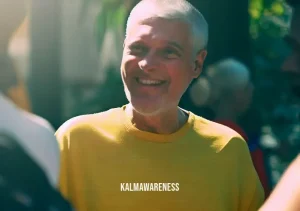Unraveling the Sitback Method Acronym: A Holistic Approach to Stress Reduction and Mindfulness
In the arena of personal growth, different techniques and approaches come to light offering a range of benefits. Among these, the Sitback method acronym stands out as a potent practice to combat stress and promote mindfulness. But what does this term encompass, and how can we implement it in our daily lives?
Let’s break it down.
SITBACK: Unfolding the Acronym
The SITBACK method is an acronym designed as an easy-to-remember, step-by-step guide to facilitate relaxation and mindfulness. Its constituent letters signify:
- S – Settle In: The journey towards mindfulness begins with settling in. It refers to the act of grounding oneself in the present moment, tuning into your surroundings, and fostering an internal environment of tranquility. It’s crucial to create a conducive environment where relaxation can take hold.
- I – Internalize: Internalization involves assimilating your thoughts and feelings, being aware of your sensations, and accepting them without judgment. As this article on watching your thoughts emphasizes, observation without reaction can be a powerful tool in fostering mindfulness.
- T – Trust: Trust is an integral part of mindfulness practice. It involves trusting in the process, in the power of meditation, and most importantly, trusting yourself. Understand the abbreviation for trust as it relates to the mindfulness journey.
Now that we have understood the first half of the Sitback method acronym, it’s time to pause, reflect, and apply these initial concepts. The beauty of this method lies in its flexibility — it can be practiced anytime, anywhere, even in the comfort of your calm home.
“In the rush of modern life, it’s easy to lose touch with the peace that is available in each moment.” – Thich Nhat Hanh
We invite you to continue with us to the next part of this article. There, we’ll delve deeper into the Sitback method acronym’s latter half, explore further resources on the site related to these concepts, and discuss how to practically incorporate this technique into your daily life for stress reduction and enhanced mindfulness.
@
B – Breathe, A – Acknowledge, C – Choose, K – Know
Continuing from where we left off, the latter half of the Sitback method acronym comprises the following steps:
- B – Breathe: Deliberate and controlled breathing can significantly aid in relaxation and grounding. For instance, techniques such as flower and candle breathing provide immediate relief from stress and foster a sense of calm.
- A – Acknowledge: Acknowledging your thoughts and emotions is pivotal in mindfulness practice. It’s not about suppression, but acceptance of what is, leading to a more calm heart.
- C – Choose: This refers to choosing your reaction to your thoughts and emotions. It’s an integral part of cultivating a detachment from overthinking.
- K – Know: This encapsulates the understanding and acceptance of the impermanence of thoughts, feelings, and life situations. The more you get to know your mental patterns, the easier it becomes to navigate through life mindfully.
Related Techniques and Methods
While the Sitback method acronym stands as a comprehensive guide, it can be beneficial to incorporate related techniques and tools to enhance its effectiveness. Here are a few mindfulness methods worth considering:
- Headspace Animations: These are animated shorts designed to illustrate mindfulness concepts visually, making them easier to grasp and remember. The Headspace animations on KalmAwareness can be a helpful resource.
- Left Nostril Breathing Before Sleep: This technique, as discussed here, can induce a calming effect and promote better sleep quality.
- Elisha Goldstein Meditation: Elisha Goldstein is a renowned mindfulness educator. Her guided meditation practices like this one can complement the Sitback method.
- Meditation for Martial Arts: Martial arts and mindfulness share common elements. As explored here, martial arts meditation can supplement the Sitback method, promoting focus and resilience.
- Deep Relaxation Techniques: Various deep relaxation techniques, as elaborated here, can go hand-in-hand with the Sitback method to combat stress effectively.
| Techniques/Methods | Description | Complementing SITBACK Step |
|---|---|---|
| Headspace Animations | Animated illustrations of mindfulness concepts | All Steps |
| Left Nostril Breathing Before Sleep | Induces calmness and better sleep | Breathe |
| Elisha Goldstein Meditation | Guided meditation practices | All Steps |
| Meditation for Martial Arts | Promotes focus and resilience | Choose |
| Deep Relaxation Techniques | Various techniques to combat stress | All Steps |
In the quest to master the Sitback method acronym and further our understanding of mindfulness, we discover an array of resources and techniques that not only complement but enhance our practice. We invite you to continue with us to the next part of the article where we will delve into common misconceptions about the Sitback method, discuss some FAQs, and provide additional resources for your mindfulness journey.

Unraveling the Misconceptions Surrounding the Sitback Method Acronym
The Sitback method acronym has revolutionized the way many perceive and practice mindfulness. However, it’s important to address common misconceptions about this method, as it can potentially hinder its successful implementation.
Misconception 1: The Sitback Method Acronym is a Quick Fix
“Everything that has a beginning has an ending. Make your peace with that and all will be well” – Jack Kornfield.
Contrary to popular belief, the Sitback method acronym isn’t an instant solution to life’s problems. The core of mindfulness is the cultivation of a new way of relating to our experiences. It’s a long-term commitment, not unlike the journey described in growing mindfully.
Misconception 2: Mindfulness and the Sitback Method is about Controlling Your Thoughts
“The best way to capture moments is to pay attention. This is how we cultivate mindfulness” – Jon Kabat-Zinn.
Practicing the Sitback method acronym doesn’t mean controlling or suppressing thoughts. Rather, it’s about understanding them and acknowledging their transient nature. It encourages one to watch your thoughts without judgment, fostering a state of equanimity.
Misconception 3: The Sitback Method Acronym is Incompatible with Busy Lives
“Drink your tea slowly and reverently… Live the actual moment. Only this moment is life” – Thich Nhat Hanh.
For individuals leading busy lives, incorporating the Sitback method may seem challenging. However, the beauty of this method lies in its flexibility. You can practice it anytime, anywhere. You don’t necessarily need to carve out specific ‘meditation time’; even a brief 20-minute meditation timer session during a break can bring about profound benefits.
Misconception 4: You Need to be Religious or Spiritual to Practice the Sitback Method Acronym
“Do not let the behavior of others destroy your inner peace” – Dalai Lama.
The Sitback method acronym, similar to the secular practice of medytacjany, is universal and not bound to any specific religion or spirituality. It’s simply a tool to navigate life’s ups and downs with grace and calm.
The Impact of the Sitback Method Acronym on Personal Growth
“Awakening is not changing who you are but discarding who you are not” – Deepak Chopra.
The Sitback method acronym empowers us to let go of negative mental patterns and embrace a healthier relationship with our thoughts. The journey may be challenging but the reward is substantial. It plays a key role in fostering personal growth, enhancing emotional resilience, and promoting a state of inner peace as discussed in mind to mindful.
In the next part of the article, we will explore some frequently asked questions about the Sitback method acronym, provide helpful tips on its implementation, and offer valuable resources to deepen your understanding and practice. Please join us on this enlightening journey to a mindful life.

Enhancing Mindfulness Through the Sitback Method Acronym: A Deeper Dive
An enriching tool for personal development and mindfulness, the Sitback method acronym, has been transforming lives across the globe. In this segment, we’ll delve into how the method works, its relevance, and the potential benefits it holds for you.
The Mechanics of the Sitback Method Acronym
The Sitback method acronym is a unique mindfulness approach that incorporates self-awareness, introspection, and a purposeful focus on the present moment. It’s an invitation to let go of unnecessary worries, release tension, and embrace serenity.
As the wise Nelson Mandela once said, “May your choices reflect your hopes, not your fears.” The Sitback method offers a pathway to make decisions driven by hope and positivity. Even during stressful situations, meditation for sleep and pain can become more effective with the Sitback method, leading to improved physical and emotional well-being.
The Sitback Method in Daily Life
The Sitback method acronym isn’t restricted to meditation sessions; it can be an integral part of your daily life. Whether it’s during a work break, a time to wine down, or even when tucking your child to bed with a conscious bedtime story, you can utilize the method to cultivate mindfulness and tranquility.
The Sitback Method Acronym’s Potential Benefits
To better comprehend the profound influence the Sitback method acronym can have on our lives, let’s review a summary of its benefits:
| Benefits | How it Works | Related Practice |
|---|---|---|
| Enhances focus | By directing your attention to the present, it fosters better concentration | ADHD mindfulness app |
| Improves emotional regulation | It helps in managing emotions more effectively | Detachment from overthinking |
| Fosters stress resilience | Regular practice enhances your ability to deal with stress | Meditation for a calm heart |
| Boosts self-awareness | By observing your thoughts, you gain a deeper understanding of yourself | Mindful heart programs |
| Promotes inner peace | It helps in cultivating a tranquil mind | Deep relaxation |
As Oprah Winfrey reminds us, “Breathe. Let go. And remind yourself that this very moment is the only one you know you have for sure.” The Sitback method acronym is a guide that aids us in living our lives in the fullness of each moment.
In the next chapter, we will take you through practical tips and steps to adopt the Sitback method acronym in your daily life. Together, we’ll explore how this unique technique can help you navigate life’s challenges with grace and confidence. Stay tuned!

Sitback Method Acronym: Unleashing its Power in Everyday Life
So far, we have explored the basics of the Sitback method acronym, its mechanism, relevance, and potential benefits. Now, let’s dive into its practical applications, exploring how to integrate this transformative method into daily life.
Morning Rituals with the Sitback Method Acronym
Starting the day on a mindful note sets the tone for the rest of the day. Whether you’re a morning person or not, integrating the Sitback method acronym into your morning routine can have profound effects. In the quiet moments of the early morning, taking a few minutes to engage with the morning anxiety meditation can help manage anxiety and promote a calmer start to the day. The practice fosters a sense of control over the upcoming day, allowing you to face it with confidence and peace.
Nourishing Body and Mind: Sitback Method and Food
The Sitback method acronym can also be a valuable ally in mindful eating. It helps us slow down, savor the food, and truly appreciate the nourishment it provides. A mindful management of food cravings can be beneficial to maintain a balanced diet, enhancing our overall well-being.
Productivity Boost at Work
At work, it’s easy to get caught in a whirlwind of tasks, meetings, and deadlines. This is where the Sitback method can be particularly effective. Short, mindful breaks can refresh the mind, improving focus and productivity. A schedule with little room for spontaneity can be made more bearable and fruitful by incorporating the Sitback method acronym during these breaks.
Practicing Mindfulness in Relationships
The Sitback method acronym isn’t just about personal growth and well-being; it can also contribute to the health of our relationships. Practicing mindfulness in interactions fosters deeper understanding, compassion, and kindness, strengthening bonds and improving communication.
Sitback Method Acronym: A Guide for Personal Growth
The Sitback method acronym is more than a mindfulness technique. It’s a journey of personal growth and self-discovery. It empowers us to be more present, attentive, and appreciative of our lives, fostering an overall sense of contentment and peace.
With this newfound understanding of the Sitback method acronym and its diverse applications, we hope you feel equipped to integrate it into your daily routines. Like a lighthouse guiding ships to safe harbor, the Sitback method can help navigate the stormy seas of daily life.
As we progress into the final chapter of our exploration into the Sitback method acronym, we’ll explore its applications in specific situations such as sleep, exercise, and relaxation. Furthermore, we’ll share expert views and testimonials on its efficacy. Stay tuned for an insightful wrap-up to our journey into the Sitback method acronym.

Sitback Method Acronym: Integration and Continuity
As we traverse the final chapter of our exploration of the Sitback method acronym, we focus on the incorporation of this practice into specific areas of life and its continuous, consistent application. After all, the real strength of mindfulness lies in its regular practice, enabling us to continuously reap its benefits.
Calm and Restorative Sleep
Sleep is a fundamental aspect of our lives, necessary for rejuvenation and healing. However, many of us struggle with restful sleep due to stress and anxiety. Here, the Sitback method acronym comes to the rescue, offering a path to serene slumbers. Using the Sitback method as part of a bedtime ritual can help reduce tension and enable the mind to switch off from the day’s activities, leading to a calm and restorative sleep. The integration of this practice can transform your nights and, consequently, your waking hours.
Exercise and the Sitback Method Acronym
Physical activity is as much about the mind as it is about the body. Mindful exercise, incorporating the Sitback method acronym, can enhance your fitness journey. Utilizing this approach during martial arts meditation, for instance, can enhance focus, discipline, and body awareness, making your workout session a holistic experience.
Anxiety and the Sitback Method
Life throws many challenges our way, and anxiety is a common response. The Sitback method acronym can be a powerful tool for dealing with these situations. Whether you are struggling with morning anxiety or experiencing stress at different times, incorporating the Sitback method can provide the much-needed calm and grounding.
Final Thoughts on the Sitback Method Acronym
Through our comprehensive exploration of the Sitback method acronym, we hope you have developed an understanding of its transformative potential. From improving sleep to enhancing productivity and managing anxiety, this simple yet effective mindfulness technique can serve as a powerful ally in your personal growth journey.
With this, we conclude our in-depth exploration of the Sitback method acronym. We hope that it has ignited curiosity, provided knowledge, and inspired you to incorporate this powerful method into your daily life.
Thank you for embarking on this journey with us, and we invite you to explore more mindfulness techniques, personal growth strategies, and stress reduction methods in our other articles. The exploration of mindfulness and personal growth is a lifelong journey, and we are here to guide you every step of the way.





